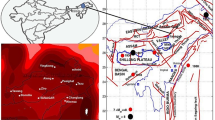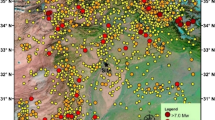Abstract
Site effects are one of the most predictable factors of destructive earthquake ground motion but results depend on the type of model chosen. We compare simulations of ground motion for a 3D model of the Mygdonian basin in northern Greece (Euroseistest) using different approximation for this basin. Site effects predicted using simple 1D models at many points inside the basin are compared to site effects predicted using four different 2D cross sections across the basin and with results for a full 3D simulation. Surface topography was neglected but anelastic attenuation was included in the simulations. We show that lateral heterogeneity may increase ground motion amplification by 100 %. Larger amplification is distributed in a wide frequency range, and amplification may occur at frequencies different from the expected resonant frequencies for the soil column. In contrast, on a different cross section, smaller conversion of incident energy into surface waves and larger dispersion leads to similar amplitudes of ground motion for 2D and 1D models. In general, results from 2D simulations are similar to those from a complete 3D model. 2D models may overestimate local surface wave amplitudes, especially when the boundaries of the basin are oblique to the selected cross section. However, the differences between 2D and 3D site effects are small, especially in regard of the difficulties and uncertainties associated to building a reliable 3D model for a large basin.










Similar content being viewed by others
References
Aki K, Larner KL (1970) Surface motion of a layered medium having an irregular interface due to incident plane SH waves. J Geophys Res 75:933–953
Bakir BS, Ozkan MY, Ciliz S (2002) Effects of basin edge on the distribution of damage in 1995 Dinar, Turkey earthquake. Soil Dyn Earthq Eng 22:335–345
Bard PY, Bouchon M (1980a) The seismic response of sediment-filled valleys. Part 1. The case of incident SH waves. Bull Seismol Soc Am 70:1263–1286
Bard PY, Bouchon M (1980b) The seismic response of sediment-filled valleys. Part 2. The case of incident P and SV waves. Bull Seismol Soc Am 70:1921–1941
Chaljub E, Maufroy E, De Martin F, Hollender F, Guyonnet-Benaize C, Manakou M, Savvaidis A, Kiratzi A, Roumelioti Z, Theodoulidis N (2014) How sensitive is earthquake ground motion to source parameters? Insights from a numerical study in the Mygdonian basin. EGU General Assembly, Geophysical Research Abstracts 16, EGU2014-11738
Chávez-García FJ (2003) Site effects in Parkway basin: comparison between observations and 3-D modeling. Geophys J Int 154:633–646
Chávez-García FJ, Raptakis D, Makra K, Pitilakis K (2000) Site effects at Euroseistest—II. Resuls from 2D numerical modeling and comparison with observations. Soil Dyn Earthq Eng 19:23–39
Chávez-García FJ, Raptakis D, Makra K, Pitilakis K (2002) The importance of the reference statoin in modelling site effects up to larger frequencies. The case of Euroseistest. In: Proceedings of the 12th European conference earthquake engineering, paper 589
Irikura K, Miyake H (2010) Recipe for predicting strong ground motion from crustal earthquake scenarios. Pure Appl Geophys. doi:10.1007/s00024-010-0150-9
Jongmans D, Pitilakis K, Demanet D, Raptakis D, Riepl J, Horrent C, Tsokas G, Lontzetidis K, Bard PY (1998) EURO-SEISTEST: determination of the geological structure of the Volvi graben and validation of the basin response. Bull Seismol Soc Am 88:473–487
Kawase H (1996) The cause of the damage belt in Kobe: “the basin-edge effect”, constructive interference of the direct S-wave with the basin-induced diffracted/Rayleigh waves. Seismol Res Lett 67:25–34
Kristek J, Moczo P (2003) Seismic wave propagation in viscoelastic media with material discontinuities—a 3D 4th-order staggered-grid finite-difference modeling. Bull Seismol Soc Am 93:2273–2280
Kristek J, Moczo P, Archuleta RJ (2002) Efficient methods to simulate planar free surface in the 3D 4th-order staggered-grid finite-difference schemes. Stud Geophys Geod 46:355–381
Makra K, Raptakis D, Chávez-García FJ, Pitilakis K (2001) Site effects and design provisions: the case of Euroseistest. Pure Appl Geophys 158:2349–2367
Makra K, Raptakis D, Chávez-García FJ, Pitilakis K (2002) How important is the detailed knowledge of a 2D soil structure for site response evaluation? In: Proceeding of 12th european conference earthquake engineering, paper 682
Makra K, Raptakis D, Chávez-García FJ, Pitilakis K (2005) Parametric analysis of the seismic response of a 2D sedimentary valley: implications for code implementations of complex site effects. Soil Dyn Earthq Eng 25:303–315
Manakou M (2007) Contribution to the determination of a 3D soil model for site response analysis. The case of the Mygdonian basin. PhD Thesis (in Greek with English abstract), Department of Civil Engineering, Aristotle University of Thessaloniki. http://invenio.lib.auth.gr/
Manakou MV, Raptakis DG, Chávez-García FJ, Apostolidis PI, Pitilakis KD (2010) 3D soil structure of the Mygdonian basin for site response analysis. Soil Dyn Earthq Eng 30:1198–1211
Maufroy E, Chaljub E, Hollender F, Kristek J, Moczo P, Klin P, Priolo E, Iwaki A, Iwata T, Etienne V, De Martin F, Theodoulidis N, Manakou M, Guyonnet-Benaize C, Pitilakis K, Bard PY (2015) Earthquake ground motion in Mygdonian basin, Greece: the E2VP verification and validation of 3D numerical simulation up to 4Hz. Bull Seismol Soc Am 105:1398–1418
Moczo P, Kristek J, Galis M (2004) Simulation of planar free surface with near-surface lateral discontinuities in the finite-difference modeling of seismic motion. Bull Seismol Soc Am 94:760–768
Moczo P, Kristek J, Galis M, Pazak P, Balazovjech M (2007) The finite difference and finite-element modeling of seismic wave propagation and earthquake motion. Acta Phys Slovaca 57:177–406
Moczo P, Kristek J, Galis M (2014) The finite-difference modelling of earthquake motions: waves and ruptures. Cambridge University Press, Cambridge. ISBN 978-1-107-02881-4
Olsen KB, Day SM, Minster JB, Cui Y, Chourasia A, Okaya D, Maechling P, Jordan T (2008) Terashake2: spontaneous rupture simulations of Mw 7.7 earthquakes on the southern San Andreas fault. Bull Seismol Soc Am 98:1162–1185
Pitilakis K, Raptakis D, Lontzetidis K, Tika-Vassilikou Th, Jongmans D (1999) Geotechnical and geophysical description of EURO-SEISTEST, using field, laboratory tests and moderate strong motion recordings. J Earthq Eng 3(3):381–409
Pitilakis K, Raptakis D, Makra K, Manakou M, Chávez-García FJ (2011) Euroseistest 3D array for the study of complex site effects. In: Gülkan P, van Eck T, Akkar S (eds) Earthquake data in engineering seismology. Springer, Heidelberg, pp 145–166
Pitilakis K, Roumelioti Z, Raptakis D, Manakou M, Liakakis K, Anastasiadis A, Pitilakis D (2013) The EUROSEISTEST strong ground motion database and web portal. Seismol Res Lett 84(5):796–804
Raptakis D, Chávez-García FJ, Makra K, Pitilakis K (2000) Site effects at Euroseistest—I. Determination of the valley structure and confrontation of observations with 1D analysis. Soil Dyn Earthq Eng 19:1–22
Raptakis D, Manakou M, Chávez-García FJ, Makra K, Pitilakis K (2005) 3D configuration of Mygdonian basin and preliminary estimate of its site response. Soil Dyn Earthq Eng 25:871–887
Smerzini C, Paolucci R, Stupazzini M (2011) Comparison of 3D, 2D and 1D numerical approaches to predict long period earthquake ground motion in the Gubbio plain, central Italy. Bull Earthq Eng 9:2007–2029
Zhang B, Papageorgiou A (1996) Simulation of the response of the Marina District basin, San Francisco, California, to the 1989 Loma Prieta earthquake. Bull Seismol Soc Am 86:1382–1400
Zhang Y, Conte JP, Yang Z, Elgamal A, Bielak J, Acero G (2008) Two-dimensional nonlinear earthquake response analysis of a bridge-foundation-ground system. Earthq Spectra 24:343–386
Acknowledgments
Part of this study was conducted within the framework of the EuroseisTest Verification and Validation Project (E2VP), co-organized by AUTH (Aristotle University of Thessaloniki, Greece), ISTerre (Institute des Sciences de la Terre, formerly LGIT: Laboratoire de Geophysique Interne et de Tectonophysique of the Joseph Fourier University of Grenoble, France) and the Cashima research program (supported by the Commissariat à l’Energie Atomique et aux Energies Alternatives—CEA—and the Institut Laue Langevin—ILL—France). KM acknowledges support from the European Union and Greek national funds—Operational Program “Competitiveness and Entrepreneurship” (OPCE II), Greece—China Bilateral R&TD Cooperation under the project number GSRT-12CHN124. FJCG acknowledges support from program UNAM-DGAPA-PAPIIT under the project number IN102813. 2D synthetic ground motion was computed with the 2DFD_DVS code, available at http://www.nuquake.eu/Computer_Codes/index.html. 3D ground motion simulations were performed by Prof. Peter Moczo, Dr. Jozef Kristek, and their group at Comenius University and Slovak Academy of Sciences, Bratislava, Slovak Republic to whom we express our gratitude for sharing their results. The comments by two anonymous reviewers were helpful to significantly improve the presentation.
Author information
Authors and Affiliations
Corresponding author
Rights and permissions
About this article
Cite this article
Makra, K., Chávez-García, F.J. Site effects in 3D basins using 1D and 2D models: an evaluation of the differences based on simulations of the seismic response of Euroseistest. Bull Earthquake Eng 14, 1177–1194 (2016). https://doi.org/10.1007/s10518-015-9862-7
Received:
Accepted:
Published:
Issue Date:
DOI: https://doi.org/10.1007/s10518-015-9862-7




